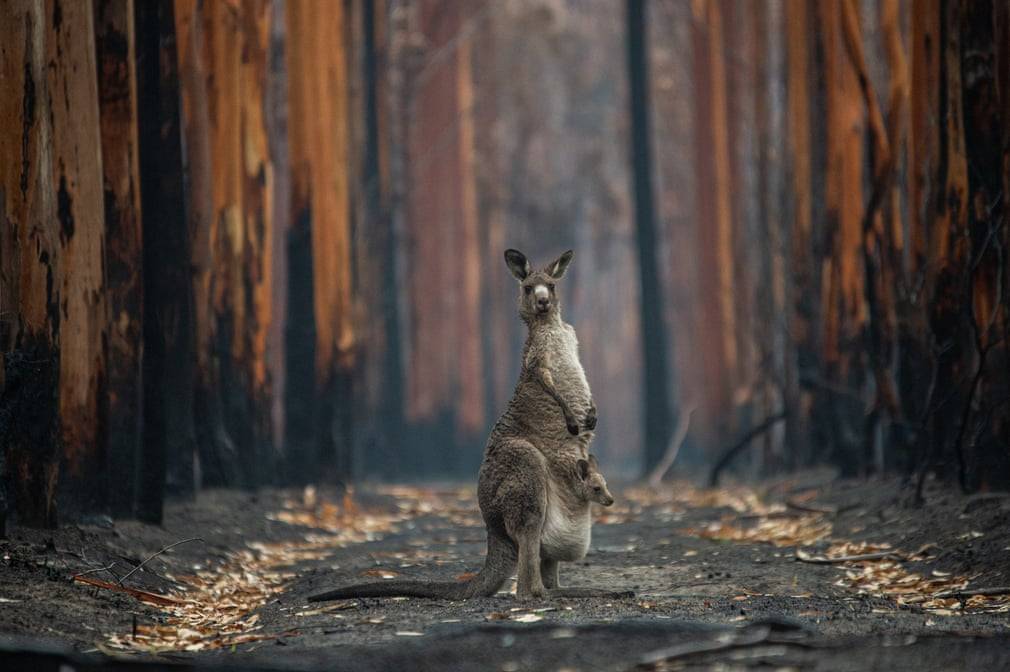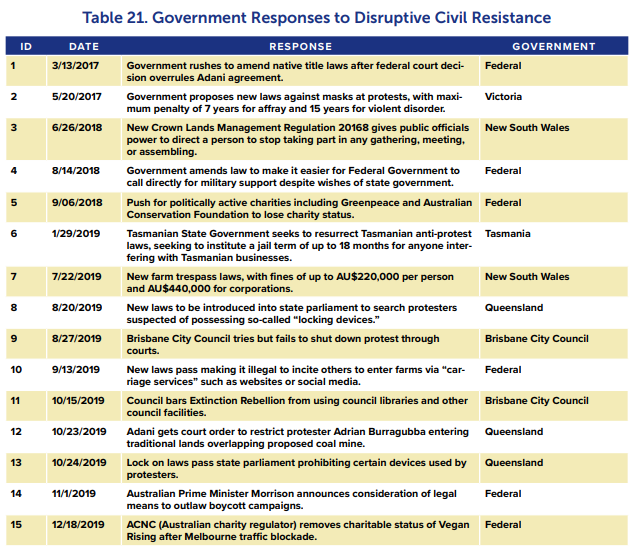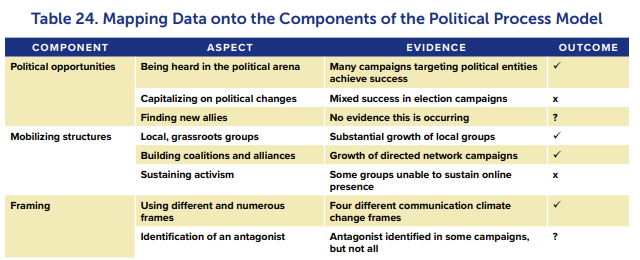Civil Resistance in The Australian Climate Movement

This is a summary of a new academic paper on the state of play in the Australian climate movement. The paper offers an analysis of the successes and failures of the movement and makes recommendations for campaigners on how to improve their rates of success.
It covers hundreds of groups and campaigns between 2010 and 2020 and focuses on two core case studies on the Stop Adani and Fossil Free movements. The original paper was written by three researchers, Robyn Gulliver, Kelly Fielding and Winnifred R. Louis.
Table of Contents
- Key Takeaways
- Context
- Civil Resistance Groups and Tactics
- State Repression
- Mapping Climate Change Civil Resistance onto Movement Frameworks
Key Takeaways
- There have been some substantial sucesses such as delaying new coal mines and securing large divestment commitments. However despite this, Australia’s response to climate change is still woefully inadequate.
- Increases in civil resistance from 2018 has also seen increases in repression. Movements will need to adapt to increased government repression particularly in the UK, US and Australia, which have introduced bans on climate protest and new police power for supression.
- Study strongly suggests that groups adopt goals and campaign targets to help motivate supporters and create clear communication materials.
- Data suggests that short-term, high-intensity activism to remove corporate pillars of support may be highly effective in delaying the development of large fossil fuel projects such as Adani Coal Mine.
Context
Climate change groups around the world arise from different contexts.
In Australia and New Zealand, concern about climate change consequences has coalesced around the impact of large development projects. Climate activism in other developed nations such as the UK and Germany has emerged out of antiwar and anti-nuclear movements. Whilesome argue that environmental groups and activists in the United States have historically neglected issues of race and justice, climate activism in that country has deep roots in the environmental justice and civil rights movements. In the global south, climate change activism has intersected with anti-globalization and anti-poverty issues. Thus, there is a huge diversity of actors and actions that together comprise the civil sector response to climate change.
Some of the earliest identified climate-related civil resistance actions to have occurred date from 2002, when Greenpeace activists shut down Esso gas stations in Luxembourg. Over the following decade actions against diverse targets flourished. Protests against mountain top removal coal mining in the United States began in 2005, “climate camps” combining eco-loving workshops with trespass and squatting began in 2006, and further protests against coal mining began spreading in many countries. The emergence of a new organization named 350.org more clearly linked climate activism with civil resistance, most particularly during two global actions against fossil fuel industries . The first 2009 Global Day of Action resulted in more than 2,500 actions in 181 countries, and the second 2016 “Break Free” actions spread across six continents, including Australia, where over 2,000 individuals blockaded the country’s largest coal port. Over the next few years, resistance activity continued .
Australian Context
Over the last few decades, Australia has begun to experience the impacts of climate change. For example, the millennium drought from 2001 to 2009 resulted in severe ecological damage to extensive river systems, causing a water crisis in most Australian cities and a major reduction in agricultural production. Catastrophic forest fires or “bushfires” in recent summer seasons—most particularly in 2009 and the 2019–20 season—are associated with the changing climate.
It also has a strong tradition of skepticism and doubt toward the need to take climate change action. This skepticism and doubt have resulted from and contributed to the so-called “climate wars” between the major political parties during the past decade. Emissions trading schemes have been proposed and shelved, a carbon pricing scheme legislated and removed, and the issue of climate change itself has destabilized and deposed prime ministers.
Civil Resistance Groups and Tactics


The environmental movement uses a wide range of tactics, particularly information sharing and eco-activities such as conservation. However, from 2018 the number of civil resistance tactics rose substantially from 541 events in 2018 to 1554 in 2019. This came with the rise of Extinction Rebellion and School Strikes for Climate.
These groups are much less likely to seek charitable or legal status in Australia due to their illegal activity. After the lawsuit on 350.org’s charitable status for its involvement in organising the Breakfree Blockade, many of these groups prefer the autonomy of no legal status. This avoids Government legal repression but it does let individuals rather than the group faces the consequences.


This table of outcomes shows that almost half of climate change campaigns organized in 2017 achieved some form of success. Campaigns targeting businesses achieved the highest proportion of success (31%), closely followed by campaigns aimed at political targets (28%).
Case Studies
Two cases studies are used and both focus on campaigns against corporations. Corporations are a key target because research shows that a small number of corporations, 90, are responsible for ⅔rds of total industrial carbon and methane emissions.
Stop Adani
The Adani coal mine is projected to release an estimated 705 million tons of carbon pollution into the atmosphere each year, which is similar to the annual emissions generated by countries such as Malaysia or Austria. The campaign has so-far failed to stop the mine but has been able to delay the project by 9 years and encourage many of its financees to withdraw support. In particular, the use of disruption by a small number of groups against specific targets—such as blockades and sit-ins in corporate offices and contractors’ workplaces—has achieved considerable success.

Stop Adani groups secured 63 wins against secondary targets, with the most wins involving targets that were going to finance the mine.
This data suggests that directing actions at secondary targets to remove corporate pillars of support may be highly effective, at the very least, in delaying the development of large projects. In addition, the data suggests that short-term, high-intensity activism against certain secondary targets may be more likely to result in success.
Divestment
The campaign to get investment funds to divest their money from fossil fuels has won in many large, key funds. However, they are mainly low hanging fruit targets such as local councils and pension funds. The vast majority of coporations, financial instituions and Universities, despite years of protest, have yet to divest. Despite early sucess in divestment, the campaign has been unable to sustain the high pressure required, particularly in Universities where many of its supporters are transient students.
As with the Stop Adani campaign, a range of civil resistance and other tactics have been used by activist groups against their targets. However, unlike the Stop Adani campaign, disruptive civil resistance does not appear to be linked to successful outcomes.
Case Study Conclusions
Analysis from the case study data indicates a higher success rate when using civil resistance tactics against corporate targets. Apart from emerging signs that local and some state governments may be prepared to announce climate emergencies or to draft supporting statements against the mine, few other wins against government have been achieved in either campaign. Although local government announcements recognizing a climate emergency indicates increased awareness of the issue, there is limited evidence that any governments are actually changing their practices or policies to reduce carbon emissions
State Repression
The Australian Government has increased repression by introducing higher fines and harsher sentences for protest. It has challenged the charitable status of environmental orgs (e.g Greenpeace, 350.org and Australian Conservation Foundation), banned protest devices (i.e lock-ons) and Brisbane Council has banned XR members from using council services.
Despite increased repression, the amount of protest groups and demonstrations has increased - likely showing the backfiring effect of increased represssion to spark outrage among the public who then join the demonstrations.
While repression in the Global South has led to the deaths of environmental activists, in the Global North/West it is more likely to take the form of increased legal pressure and reducing the rights of protest. For example, the Federal Government challenged the charitable status of 350.org for its support of illegal activity in the Breakfree Blockade in Newscatsle Coal Port inn 2016. Higher fines have been introduced for activists as high as AUS$10,000 for an XR coal train blockade in 2019. There have been approximately 536 arrests of climate activism since 2016.
Despite these challenges, the movement has been able to adapt to a range of repression through its often decentralised structure. The main groups are not charged fines on a national scale because of their lack of organisation status. Other established organiations often help them with any legal challenges and legislation they require.

Mapping Climate Change Civil Resistance onto Movement Frameworks
There are range of models that have proposed the necessary requirements for social change. This section takes the data from the Australian movement and maps it on those models to see if they are filling the criteria.
Joanna’s Macy Great Turning Model
- Holding Actions and Resisting ✔️
- Creating Alternative Structures - Limited amount of work to build local resilience, mainly by Transition Towns and XR.
- Shift in Consciousness and Values - Limited data but signs of a shift in support for Biodiveristy, Eco-Education, Religious Environmentalism and Green Party.

Brecher’s Climate Insurgency Model

Political Process Model

I hope you found this summary helpful and that it helps to develop your activism. If you are interested in more like this, sign up to my newsletter.
Learn more on civil resistance and help hone your rebellious craft!
Disclosure: If you buy books linked on my site, I may earn a commission for coffee money from Bookshop.org, whose fees support independent bookshops 📚☕